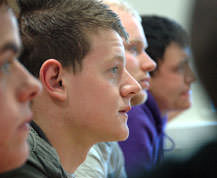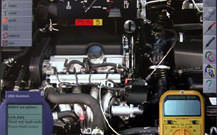Fault-finding – Bromley College
“The most challenging aspect of motor vehicle work-based programmes is teaching engine management diagnostic skills. Vehicles are becoming increasingly technically advanced and more reliable. This means that not only are faults harder to find, but also that apprentices have less opportunity to practice their diagnostic skills in their work places.
The software solution we’ve found for this problem is amazing – the graphics are actual photographs of an engine and sound is like the real thing – an important sense to use when diagnosing problems. And because it’s a computer ‘game’ it taps straight into the youth culture – so learners love it.”
Advice for others? “There is a good range of fault diagnosis programs on the market and it doesn’t matter which one you buy. As long as you are keen on it, you’ll excite the learners and they’ll buy into it too.
Errol Ince – Head of Engineering
 This case study is an illustration of one of the fundamental elements of any good lesson. With its emphasis squarely on teaching the learners how to become independent thinkers, the teacher’s approach is dominated by the ‘coaching’ of the learners’ understanding, rather than the delivery of information – an approach that teachers from any vocational area could benefit from.
This case study is an illustration of one of the fundamental elements of any good lesson. With its emphasis squarely on teaching the learners how to become independent thinkers, the teacher’s approach is dominated by the ‘coaching’ of the learners’ understanding, rather than the delivery of information – an approach that teachers from any vocational area could benefit from.
“The program is fairly easy to use if you have a good understanding of diagnostics”, says Errol, “so the time you have to invest in actually working out how the software package works is very limited – you probably only need an hour or two.”
Setting up a fault is simply a matter of selecting a scenario from the database. Learners then have access to on-screen versions of all the test equipment they would find in their garage workplaces to help them solve the problem.
 “One of the benefits of the simulator programme,” says student Stefan Jedrzeski, “is that it allows you to learn by trial and error – if you do make a mistake it allows you to rectify it and try again.”
“One of the benefits of the simulator programme,” says student Stefan Jedrzeski, “is that it allows you to learn by trial and error – if you do make a mistake it allows you to rectify it and try again.”
 Michelle Beckham, an apprentice from a Vauxhall main dealership: “It’s a lot harder to diagnose new cars when they come in with a fault because you’ve got so many more things it could be. The computer program helps us to learn how to quickly narrow down options and pin-point what the problem is.”
Michelle Beckham, an apprentice from a Vauxhall main dealership: “It’s a lot harder to diagnose new cars when they come in with a fault because you’ve got so many more things it could be. The computer program helps us to learn how to quickly narrow down options and pin-point what the problem is.”
Most of Errol’s lecturing staff now use the diagnostics program, but we caught up with one colleague, Simon Wild, who at the time of writing, had yet to assimilate the system into his teaching. As can be seen in the good practice film above that accompanies this case study, Simon really liked the overall approach: “You can easily put over quite a complex problem which would be difficult to arrange in a workshop, especially with a group this size. Our workshops are being used all the time and it would be difficult to set these up, and difficult to get all the students round the engine rigs or cars. With this program, you can easily see all the  components.”
components.”
 “We’ve used the program with our level 3 students for a while now,” says Errol, “and they’ve found it fun and are really enthusiastic about using it as a tool to develop their skills and become very competent at diagnosing problems.”
“We’ve used the program with our level 3 students for a while now,” says Errol, “and they’ve found it fun and are really enthusiastic about using it as a tool to develop their skills and become very competent at diagnosing problems.”
“I think it’s amazing,” says Michelle, “I think everywhere should have one (diagnostic program), because even if you’re just messing around on it, you learn so much – it’s so easy to see how everything works.”
In the college’s inspection report , inspectors highlighted this area as a key strength:
- highly innovative use of ILT to support teaching and learning in motor vehicle lessons.


